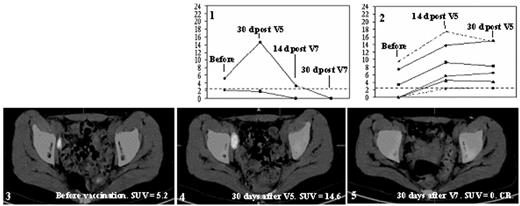Abstract
Except in the subset of patients with localized disease, follicular lymphoma (FL), the most common type of indolent non-Hodgkin’s lymphoma, should still be regarded as an incurable malignancy with a relentless relapsing course. New therapeutic approaches have been developed including anti-tumor vaccination strategies with induced humoral and cellular immune responses revealed by sensitive biological analyses but no imaging of the lymphocyte activation developed so far. Because [18F]fluorodeoxyglucose (FDG) is sequestred in metabolically active cells, we prospectively investigated the use of FDG-PET (positron emission tomography) to kinetically monitor cell activation in 7 FL patients vaccinated by repeated intradermal (ID) and intravenous injections of tumor lysate-pulsed autologous dendritic cells (DC-lysate). Patients were administered 5 vaccines and all patients developed a positive delayed-type hypersensitivity reaction at the site of DC-lysate ID injections after several vaccines administration, testifying of the induction of a biological response. Among the 4 patients with measurable disease at time of vaccination, 2 complete remissions (CR) and 2 disease progressions were observed. Three patients with initial normal computed tomographies (CT) were still in CR 12 months after the last vaccine. PETs were performed before vaccination, 14 days and 1 month after the last vaccine. PET revealed initial malignant nodes infracentimetric on concomitant CT, and was very sensitive in documenting disease progression even in patients with no significant variations of CT findings. A transient marked increase in FDG uptake within malignant nodes was observed early after vaccine administration in a patient who achieved a CR (fig 1-3-4-5), while ranges of tracer uptake variations were less important with a continuous increase of FGD uptake, size and number of involved loci in non responding patients (fig 2: follow up of intensity of FDG uptake by 6 tumoral nodes in a non responding pt). In conclusion, FDG-PET is a non invasive imaging procedure which besides being useful for the staging and the evaluation of treatment efficacy in FL, might be of crucial interest to detect cell responses induced by immunotherapies.
Disclosure: No relevant conflicts of interest to declare.
Author notes
Corresponding author


